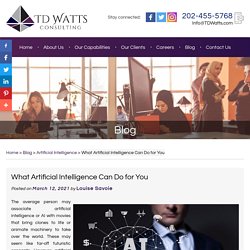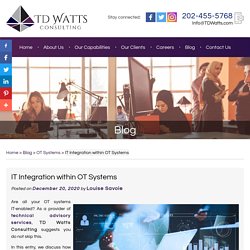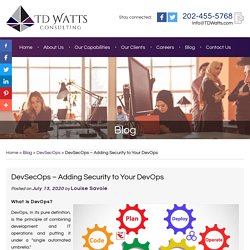

What Artificial Intelligence Can Do for You. The average person may associate artificial intelligence or AI with movies that bring clones to life or animate machinery to take over the world.

These may seem like far-off futuristic concepts. However, artificial intelligence actually exists in our daily lives without us noticing. In fact, they can be useful in improving business workflow management and other tasks. As a provider of technical advisory services, we have helped businesses integrate the use of artificial intelligence in their workflow. Here are some of the applications of artificial intelligence in businesses: Automate workloads and increase manufacturing efficiency Machine learning algorithms can categorize work and automatically route service requests. Determine whether you can reach your performance goals through AI applications. IT Integration within OT Systems. Are all your OT systems IT-enabled?

As a provider of technical advisory services, suggests you do not skip this. In this entry, we discuss how the OT (Operational Technology) systems’ integration of IT (Information Technology) capabilities and innovations were sure, but a slow progression, and why half the success of keeping IT-enabled OT systems is in maintaining them. To begin, it is helpful to understand that such integration was only a matter of time considering the pace that IT (Information Technology) has advanced. Remedying Technical Uncertainties in QRA. A Quantitative Risk Analysis (QRA) is a modeling technique that presents the risks, and the financial impacts of the identified risks, more explicit to the business owners when making any business decisions.

However, due to the lack of consensus concerning methods, inputs, and models that should be used in the analysis, uncertainties will arise, and questions will be asked about the credibility and usability of the QRA. So how do we remedy these technical uncertainties that come up? ModelsAlthough there is no perfect model, making use of several parallel models to compare the results is a way to enhance the credibility of the results.
To make an effective model, one must be comprehensive in specifying the scenario or problem that the model is trying to address.Expert JudgementThere could be data from experts that do not coincide with each other. We also provide systems integrations for your IT and OT systems. DevSecOps – Adding Security to Your DevOps. What Is DevOps?

DevOps, in its pure definition, is the principle of combining development and IT operations and putting it under a “single automated umbrella.” It has helped organizations deliver applications and services quickly. At the same time, it has accelerated the evolution and improvement of these services than organizations that are still using traditional software development and infrastructure management processes. Its Flaws However, due to its high-performing nature, many security and compliance monitoring tools still cannot keep up with the change and cannot test code at a speed that is required by DevOps applications.
Why Is DevSecOps Important? With DevSecOps, it allows this integration to function with added security. An Introduction to the Modern Architecture of Cybersecurity. Nowadays, business organizations use either on-premise software, cloud-based software, or a combination of both to store their data and manage their system functionality.

Without proper cybersecurity, companies and organizations vulnerable to cyber threats, such as password phishing or advanced persistent threats, among others. By incorporating today’s cybersecurity architecture into their on-prem or cloud infrastructure, they organizations can avoid losing data or having their data stolen reduce the risk of corruption, disclosure, or loss to both system functions and data. This also includes increasing corporate capabilities such as daily security management, like patching, updating definitions, and the like. So what are the emerging modern cybersecurity architectures that can prevent modern-day cyber threats? Zero Trust is an emerging architecture approach currently being explored and published within the National Institute of Standards and Technology (NIST).
Complex Layers of Cybersecurity: What You Should Know. Companies, especially big enterprises, rely on cybersecurity to keep their data from falling into the wrong hands or lose their data due to malware.

However, cybersecurity in itself is simply a big term made up of very many layers. The architecture of a company’s cybersecurity should be people, technology, and processes working together to protect the enterprise’s assets and data. As mentioned earlier, cybersecurity is made up of different layers, namely: Physical LayerPerimeter LayerNetwork LayerHost LayerApplication LayerData LayerCompliance Layer All of these layers work from the outside and work independently, meaning they don’t interact at all that leads to allowing threats to move up and down the layers or even laterally, causing mishaps within the organization.
With all the security applications companies may have within every layer, it can be both costly and risky on their part. We provide technical advisory services for both enterprises and emerging companies. How IT and OT Converge in Business Operations. With businesses continually integrating new technologies into their operations, there’s no surprise that when information technology and operation technology work hand in hand, they produce efficiency and security in business processes.

In turn, when one or the other is affected, it can compromise the whole operation as well. So how do these two affect each other and optimize business operations specifically in manufacturing businesses? But while it has been beneficial for producing efficient output and managing operations, there may be risks of security holes.